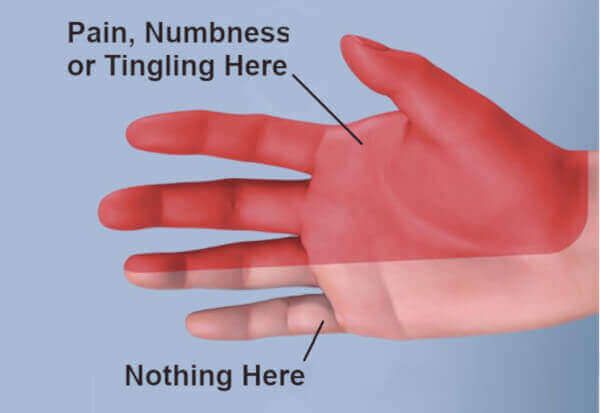Hands Hurt Driving: Maybe it's Carpal Tunnel
Table of Contents
- Overview
- If your hands hurt driving, it’s probably carpal tunnel
- Why hand pain, driving & carpal tunnel go together
- Gripping the steering wheel
- Mechanical vibration
- How to treat carpal tunnel
- Conservative (nonsurgical) treatments
- Surgery
- Summary
- FAQs
- About
Overview
Do your fingers or hands hurt when you drive? Perhaps they tingle, feel
numb, or ache after gripping the steering wheel for just a few minutes. These sensations are not just inconvenient — they may be a warning sign of
carpal tunnel syndrome.
In fact, pain or numbness while driving is often when most people first notice this condition. According to the
National Institutes of Health (NIH), symptoms such as tingling, burning, or weakness in the fingers and hands—especially during steady activities like driving—should never be ignored.
Here’s why it happens: when you hold a steering wheel, your wrists are bent and your grip remains firm for an extended time. This posture compresses the median nerve as it passes through the carpal tunnel in your wrist. Combine that with the constant vibration of the vehicle, and it’s the perfect setup for nerve irritation and restricted blood flow. The result is pain, tingling, or that familiar “pins and needles” feeling spreading into your fingers.
While carpal tunnel syndrome is the most common cause, other conditions such as tendon inflammation, arthritis, or circulatory problems can also contribute to discomfort while driving.
This article explains what’s happening inside your hands, how to distinguish between causes, and what steps you can take to prevent worsening pain or nerve damage.
If your hands hurt driving, it’s
probably
carpal tunnel
Carpal tunnel syndrome is one of the most common medical disorders seen by doctors. And it
the most common
disorder of the hand. What's most alarming is the incidence of
carpal tunnel syndrome is increasing dramatically every year.
Most people with early or
mild stage carpal tunnel syndrome are not even aware they have it. That's why the first sign many people get that the condition has started is when their hands hurt while driving a car.
People often just pass it off and say they have “tired hands" without understanding how serious it might be a year from now. So if you have finger or hand
pain,
numbness, tingling (pins & needles),
shooting electric shocks,
weakness or clumsiness, be smart and pay attention. If the same thing happens when holding a phone, coffee cup, frying pan, or any time you grip something tightly, you should get help now.
Note that carpal tunnel syndrome can first appear as any one or all of those symptoms in the hand or fingers. Pain can manifest as different kinds of sensations, running the whole spectrum of discomfort. These include feelings like sharp or stabbing pain, stinging, burning or grinding pain. In others it might feel like aching, throbbing or a dull pain.
The sensation of pain is different from person to person. It can even change over a few weeks from one sensation of pain to another.
Pain is usually
felt along with numbness or tingling. It's also often accompanied by hand weakness. In more
severe carpal tunnel cases, patients begin
losing grip strength and dexterity. That makes it hard to make a fist, create a pinching action, or pick up small objects like coins or keys.
Therefore, if your hands hurt while driving, you've probably lost some grip strength, too.
Why hand pain, driving & carpal tunnel go together
The NIH is very clear that the relationship between having your hands hurt, driving & carpal tunnel is rising dramatically. In other words, the cases of carpal tunnel syndrome are increasing in
frequency.
The reason for this problem showing up while driving is two-fold:
- Maintaining a grip on the steering wheel, and
- Mechanical vibration from the car
These two reasons for acquiring carpal tunnel syndrome are also seen in certain industries. For instance, workers who use
power hand tool use (vibrating tools) are prone to getting carpal tunnel syndrome. So are people who spend hours gripping other types of vibrating equipment (construction workers,
hair stylists, motorcycle riders, floor polishers, etc.).
Gripping the steering wheel
Driving your car requires you to grip the steering wheel. As a general rule, gripping requires your fingers to curl. That means your
flexor tendons are pulling your finger bones tightly. In fact, they do so with surprisingly great force.
Any such gripping strains the flexor tendons. And if you're already
prone to carpal tunnel syndrome (or have it) those tendons are on the verge of failing. Gripping a steering wheel merely pushes the tendons over the brink.
That’s why feeling unpleasant symptoms while gripping a steering wheel is when many people first notice they have a problem in their hands.
Mechanical vibration
In addition to gripping the steering wheel, there’s another problem that driving causes. Most cars transmit small, high speed vibrations from the road and engine. It travels up and into the steering wheel and into your hands.
It's very well documented that vibration contributes to causing carpal tunnel syndrome. In fact, a related condition called
vibration syndrome can happen with excessive hand vibration.
So combining the gripping action
plus
the steering wheel vibration creates a perfect storm for making your hands hurt:
driving & carpal tunnel syndrome are definitely related!
Note: Vibration damage is the reason doctors advise patients to NOT use a vibration massager to relieve symptoms of carpal tunnel syndrome.
How to treat carpal tunnel
Carpal tunnel syndrome can be treated using a number of remedies. Most doctors advise using a combination of conservative remedies first. If they don't provide relief, then you may require surgery.
Recommended conservative treatments are over-the-counter pain relievers, rest and activity modification, stretching exercises, night bracing, and myofascial massage. When these conservative treatments fail, you can try minimally invasive treatments like steroid injections or hydrodissection of the median nerve. Carpal tunnel release surgery is reserved for the most severe cases.
Conservative (nonsurgical) treatments
- Over-the-counter pain relievers: Drugs like naproxen, acetaminophen, and ibuprofen can help reduce inflammation and pain.
- Rest and activity modification:
Avoiding or reducing the activities that aggravate symptoms is important. You can also take frequent breaks while doing stressful hand tasks.
- Stretching exercises:
There are
4 cores stretching exercises known to be effective for carpal tunnel.
- Night bracing:
Bracing your wrist in a neutral (straight) position while you sleep can reduce pressure on your median nerve.
- Myofascial release massage: This therapy targets the underlying tissues around your median nerve, and reduces pressure on the nerve. It can be performed by a therapist or
with the CarpalRx.
- Steroid Injections:
Your doctor can inject
corticosteroids into your wrist to help reduce inflammation and pain.
- Hydrodissection:
Hydrodissection of the median nerve can free it from being trapped and restricted inside your wrist joint.
Surgery
When conservative, nonsurgical remedies don’t work, your doctor may recommend surgery. All carpal tunnel release surgery requires cutting the transverse carpal ligament inside your wrist. This allows your wrist bones to snap apart, creating more space and thereby relieving pressure on the median nerve. There are two basic types of surgery for carpal tunnel: open vs. endoscopic.
There are pros and cons to both procedures.
- Open carpal tunnel release surgery:
This requires a larger incision in your palm so the doctor can visualize all of the structures. It is generally more painful.
- Endoscopic carpal tunnel release surgery: This requires one or two smaller incisions because an endoscopic camera is used for the procedure. It is generally less painful.
Summary
It’s most likely the reason your hands hurt driving is due to carpal tunnel syndrome, primarily due to it's high incidence rate. And it’s also likely you had this disorder lurking the background for a long time without noticing it. But now it has probably advanced. Gripping the steering wheel combined with automotive vibration is the reason you're feeling the problem now. The gripping and vibration has caused your already damaged and inflamed tendons to get even worse. And as they worsen, symptoms come to the forefront. This is the time to do something about it before symptoms become even more severe.
FAQs
- I have carpal tunnel but I have to drive long distances. What can I do to keep symptoms down?
You can do two things that make a big difference. First, do
stretching exercises for your fingers and hands while driving. Second, wear driving gloves to better protect your hands.
- Stretching exercises and wearing driving gloves has not helped my carpal tunnel. What else can I do?
You likely require more aggressive therapy. This includes night bracing and myofascial release massage.
Learn more here.
- Is motorcycle riding bad for carpal tunnel?
Yes, there are several factors which make motorcycle riding bad for carpal tunnel. These include needing to tightly grip the handle bars for extended periods of time, gripping and squeezing the levers, significant vibration on the handlebars, exaggerated wrist flexion and extension, and holding your hands out and elevated for prolonged periods of time.
About





